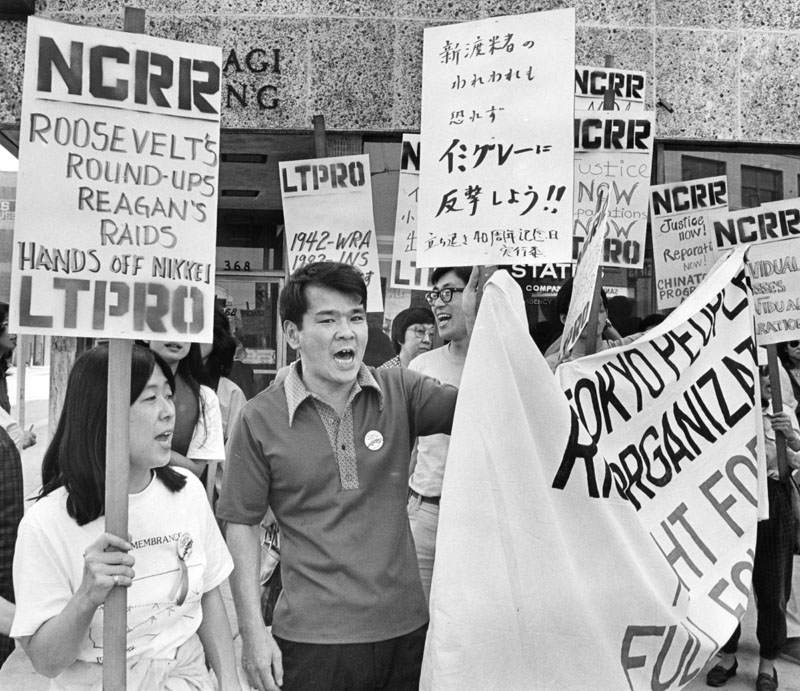October 5, 2021
Japantowns in the U.S. have been shaped by a long history of both exclusion and resilience — from the dispossession of Indigenous peoples to the forced removal of Japanese Americans during WWII to anti-eviction movements that rose up against “urban renewal” in the 1970s. At a moment when these neighborhoods are once again acutely threatened by gentrification and displacement, this history holds powerful lessons for those who wish to fight for the future of Japantown.
In this conversation from Tadaima! 2021 panel, “J-town Here to Stay: Displacement and Community Resilience in Japantown,” Densho’s Nina Wallace discusses the historical roots of contemporary struggles against displacement with Mario Correa and Zen Sekizawa of L.A. based J-town Action と Solidarity, San Francisco artist and activist Eryn Kimura, and Karen Akada Sakata of Seattle’s CID Coalition.
Watch below to hear about the fight to preserve Japantowns as equitable and inclusive neighborhoods, how gentrification is linked to larger structures of white supremacy and settler colonialism, and why solidarity across all of our communities is the only way forward. Then scroll through for a list of resources to learn more and get engaged!
Resources on Displacement in Japantowns
The History of “Redevelopment” in Japantowns
Read The Gateway to the Pacific: Japanese Americans and the Remaking of San Francisco by Meredith Oda for a history of how redevelopment shrank San Francisco’s Japantown from 40 blocks down to a 4-block shopping center.
“Uncle” Bob Santos was a prominent figure in the fight to preserve Seattle’s Chinatown-International District, sparked by youth-led protests against construction of the Kingdome next to the historic center of the city’s Asian and Asian American community. His memoir, Hum Bows, Not Hot Dogs, tells the story of that movement.
The radical Asian American newsletter Gidra, which ran from 1969-1974, covered debates around and struggles against redevelopment in Little Tokyo:
- George Umezawa and Evelyn Yoshimura, “Redevelopment… or the Rape of Little Tokyo.” Vol. V, No. 2 (February 1973), 10.
- Evelyn Yoshimura, “Higher Rises, Lower Depths: Redevelopment and Little Tokyo.” Vol. V, No. 3 (March 1973), 11-13.
- Dean Toji, “The Housing Crisis in Little Tokyo and a Case for Blackmail in Seeking Reparations.” Vol. V, No. 12 (December 1973), 7-10.
Explore this timeline of redevelopment in Little Tokyo from 1941-2014 from KCET.
Listen to Densho interviews with activists who were involved in anti-displacement fights in Los Angeles and Seattle:
The Seattle Civil Rights & Labor History Project’s Asian American Movement collection documents community activism to protect the Chinatown-International District from encroaching development in the 1970s.
Watch footage from protests against redevelopment in San Francisco’s Japantown from the Bay Area Television Archive at San Francisco State University:
- Opposition to Redevelopment in Japantown (September 1974)
- Sutter-Laguna Tenants Protest Redevelopment Agency (August 1975)
- Nihonmachi Tenants Protest at City Hall (August 1975)
The documentary Crossroads in Nihonmachi, directed by Adrianne Anderson and Tony Sondag and produced by Boku Kodama of Urban Voice, documents the struggle against redevelopment in San Francisco in the 1970s.
J-town Communities Fighting Displacement Today
J-town Action と Solidarity is a grassroots collective building community power and fighting inequitable development in Little Tokyo and across Los Angeles. Here are a few ways to plug into their work:
- Join their weekly mutual aid power ups with We the Unhoused.
- Sign the MOKUYOBI MUST GO petition.
- Join the JAS reading group.
The CID Coalition (also known as #HumbowsNotHotels) is working to fight gentrification and displacement in Seattle’s Chinatown-International District. Follow @humbows_not_hotels on Instagram to track predatory development in the CID and learn how to take action.
“Who Keeps Us Safe?” a new podcast from PARISOL (Pacific Rim Solidarity Network) explores safety, policing, and abolition in Asian American communities and beyond. Listen to Episode 2, “CID Not For Sale,” to learn about the connection between gentrification and public safety.
JAS and Nikkei Progressives recently hosted a series of discussions on displacement in Little Tokyo. Learn about “art washing” and how it contributes to gentrification from their 7/28 Sip & Share presentation. (And subscribe to the Nikkei Progressives newsletter to hear about future Sip & Shares and other issues in Little Tokyo!)
In San Francisco’s Japantown, the Department of Homelessness and Supportive Housing recently proposed converting the Buchanan Hotel into permanent supportive housing for unhoused residents. Watch a recording of a recent community discussion and Q&A about this proposal hosted by Japantown for Justice, and read J4J’s “Things to Consider about the Buchanan Hotel Project” and statements from Nikkei Resisters, Japantown Task Force, former Committee Against Nihonmachi Evictions (CANE) members, and SF Japantown community members to learn more.
[NOTE, 10/27/2021 – The proposed conversion of the Buchanan Hotel in San Francisco’s Japantown will not move forward, after the owners, KHP Capital Partners, announced they will not sell the property to the city.]
—
[Header photo: Members of the Little Tokyo People’s Right Organization at a Nikkei for Civil Rights & Redress protest in 1988. LTPRO formed in 1973 to fight evictions of low-income Little Tokyo residents triggered by redevelopment, and eventually shifted into NCRR.]
10/20/2021 – This post has been updated with additional resources on San Francisco Japantown, provided by former CANE member Joyce Nakamura.
